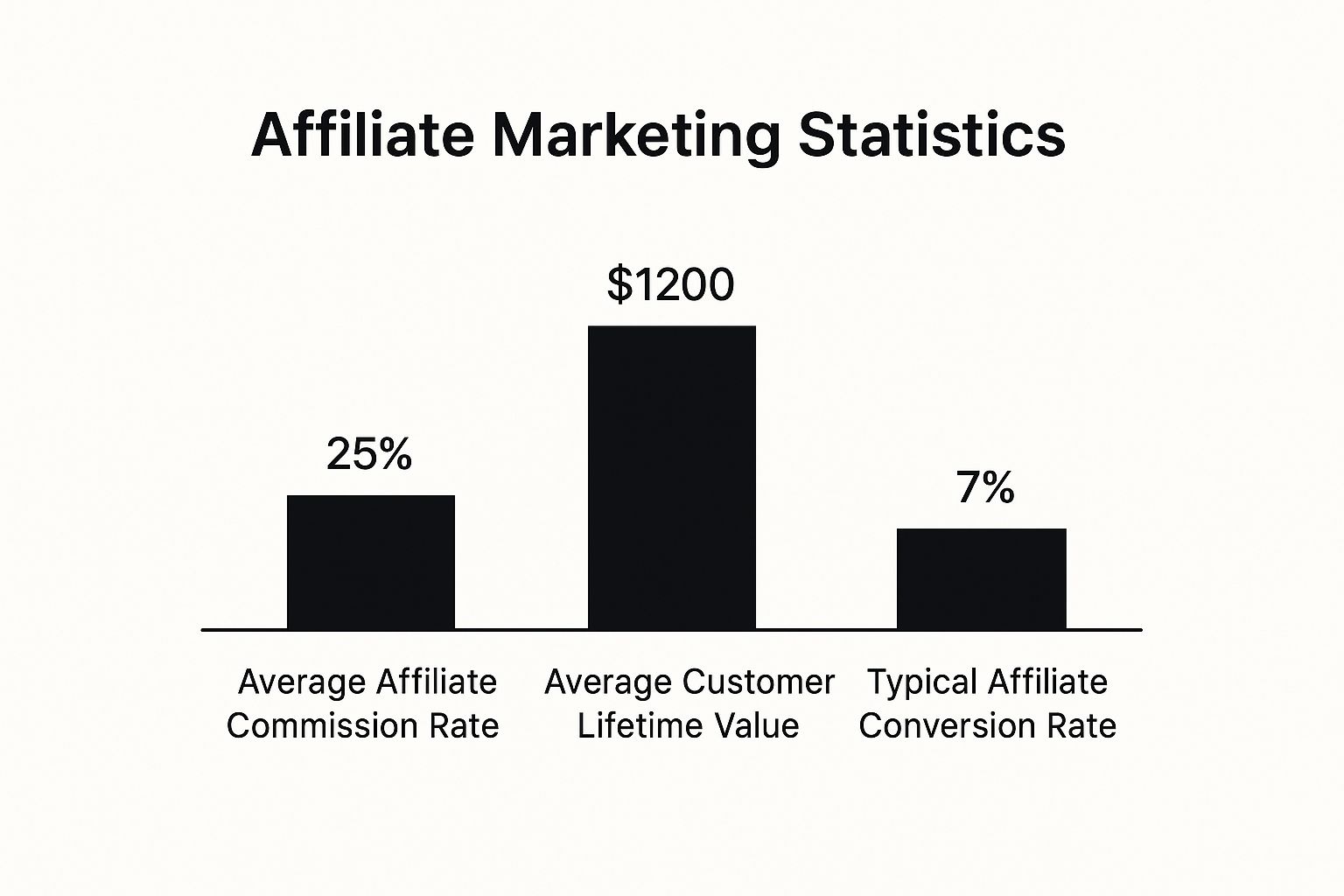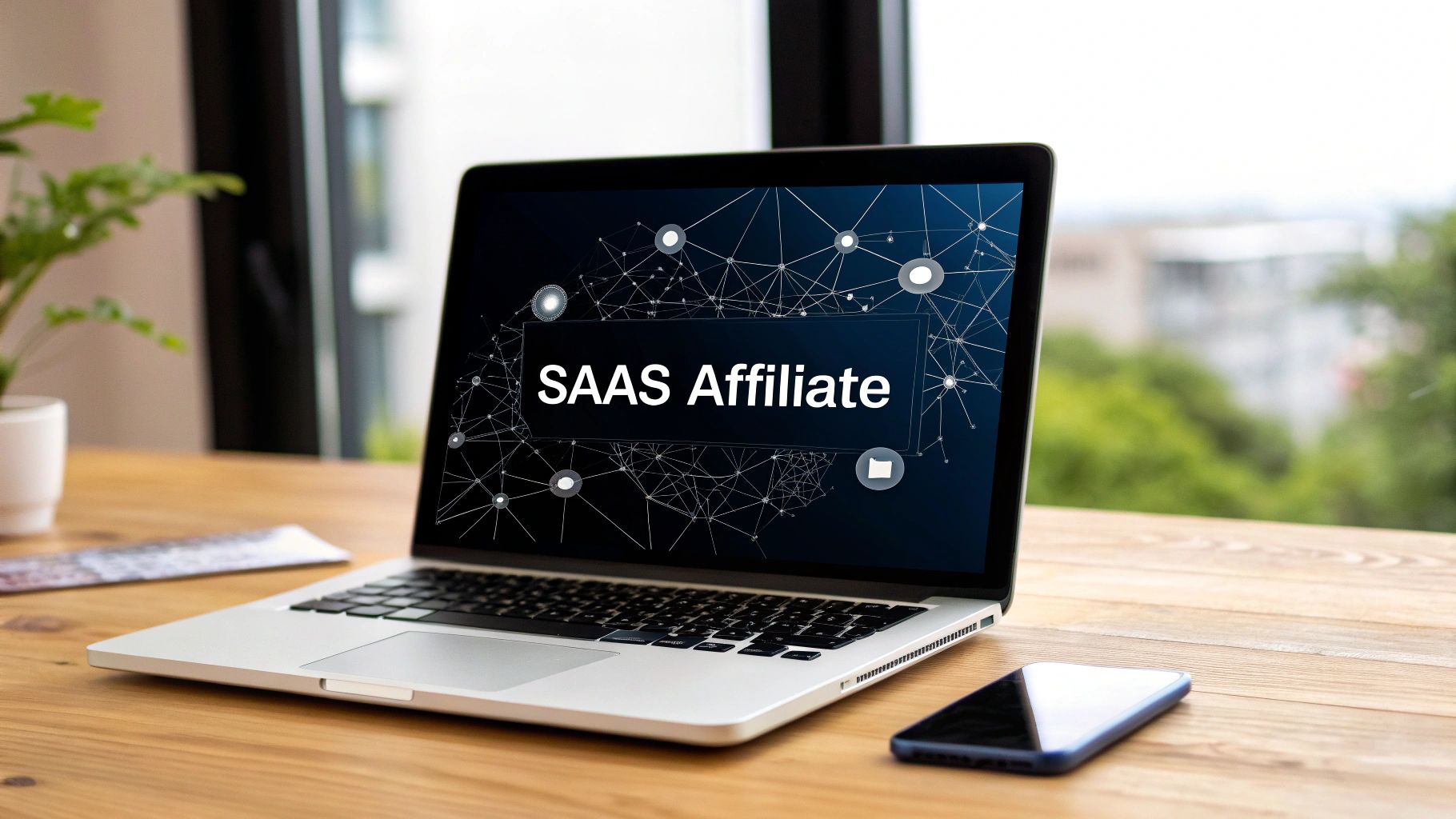Imagine having a sales team that works around the clock to promote your software, and you only pay them when they deliver results. That's the essence of SaaS affiliate marketing. This isn't just about chasing one-off sales; it's about forging strategic partnerships to build long-term, recurring revenue by turning trusted creators into powerful advocates for your brand.
What Is SaaS Affiliate Marketing, Really?
At its core, SaaS affiliate marketing is a performance-based model. You partner with individuals or companies—your affiliates—to promote your software. Instead of paying for ad space or impressions upfront, you pay them a commission for each new customer they bring in. Think of it as your own decentralized, results-driven sales force.
Where this model really shines is how it differs from traditional affiliate marketing, which usually focuses on physical products and single payouts. The SaaS world, with its subscription-based revenue, creates a powerful win-win scenario for both the company and its partners.
This infographic breaks down some of the key numbers that make the SaaS approach so appealing.

As you can see, it's not just about solid conversion rates. The real magic happens when you combine high commission rates with a substantial customer lifetime value—that's what makes these programs so potent.
The Power of Recurring Revenue
The single biggest game-changer in SaaS affiliate marketing is the prevalence of recurring commissions. When an affiliate refers a customer who signs up for a monthly or annual plan, that affiliate earns a percentage of every payment for as long as the customer stays subscribed.
This model fundamentally shifts the motivation. It pushes affiliates to do more than just drive initial sign-ups; it incentivizes them to attract high-quality, loyal customers who will stick around. These are the users who directly fuel your Monthly Recurring Revenue (MRR).
This dynamic creates a genuine partnership. Your affiliates become deeply invested in your product's success and your customers' happiness because their long-term income depends on it. This alignment is what transforms the channel from a simple lead source into a sustainable growth engine.
SaaS vs Traditional Affiliate Marketing at a Glance
To really see the difference, let’s compare the two models side-by-side. The table below highlights the fundamental distinctions in everything from commission structure to the very nature of what's being sold.
| Feature | SaaS Affiliate Marketing | Traditional Affiliate Marketing |
|---|---|---|
| Commission Type | Primarily recurring, tied to subscription renewals. | Typically one-time payout per sale. |
| Product Nature | Digital software, services, and subscriptions. | Often physical goods, digital downloads, or one-off services. |
| Revenue Potential | High long-term potential from a single referral. | Revenue is limited to the initial transaction. |
| Customer LTV | A primary focus for both company and affiliate. | Lower priority; the focus is on the immediate sale. |
| Partnership Model | A long-term partnership focused on customer retention. | More of a transactional relationship. |
This comparison makes it clear: SaaS affiliate marketing isn't just a different flavor of the traditional model—it's a completely different strategic approach built for long-term, compounding growth.
Who Are SaaS Affiliates?
So, who are these partners? The best ones are almost always people who already have an established, trusted voice within your niche. They aren't just random marketers; they are credible sources of information your ideal customers already listen to.
Your key affiliate partners will often include:
- Content Creators and Bloggers: Experts who publish in-depth software reviews, how-to guides, and comparison articles for your industry.
- YouTubers and Podcasters: Influencers who create video demos or discuss tools that help their audience solve specific problems.
- Industry Consultants: Professionals who recommend software solutions to their own clients as part of their service.
- Existing Power Users: Your most passionate customers who can authentically promote your product because they use it, love it, and know it inside and out.
The global affiliate marketing industry is massive, having grown from $27.8 billion to $32.3 billion in recent years. Within this boom, SaaS programs truly stand out, with commission rates often ranging from 20% to 70%—making them some of the most lucrative partnerships out there. For those looking to build a strong foundation, mastering affiliate marketing provides essential knowledge that can be directly applied to your SaaS program.
The True Benefits of a SaaS Affiliate Program

Sure, an affiliate program can boost your revenue. But thinking of it as just another sales channel is missing the bigger picture. A well-run SaaS affiliate program is a powerful growth engine that delivers strategic advantages that multiply over time, changing the very way you find and keep customers.
The most obvious win is cost-effective customer acquisition. Let's be honest, traditional advertising can feel like you're just throwing money at a wall, hoping some of it sticks. You pay for clicks and impressions whether they convert or not. Affiliate marketing flips that script. It’s a pure pay-for-performance model—you only pay a commission after a sale is made. This simple shift drastically lowers your financial risk and makes every marketing dollar count.
Building Authentic Brand Credibility
In today's world, trust is everything. Traditional ads are losing their punch because people are skeptical, and rightly so. In fact, a whopping 86% of consumers say that recommendations and reviews are critical when they're deciding what to buy.
This is where your affiliates truly shine. When a respected blogger or an industry influencer your ideal customer follows recommends your software, it's not an ad—it's an endorsement. It’s a stamp of approval from a source they already know and trust.
An affiliate's recommendation is one of the most powerful forms of social proof you can get. It essentially tells potential customers, "Hey, someone I respect uses this and thinks it's great, so it’s probably worth checking out."
That kind of third-party validation cuts through the marketing noise and builds a foundation of credibility before a prospect even lands on your pricing page.
Penetrating Niche Markets
No matter how brilliant your marketing team is, they can't be everywhere. There are countless niche communities, specialized forums, and private groups where your ideal customers hang out, but your ads will never reach them effectively.
Your affiliates, on the other hand, are already there. They’re insiders.
Think about a niche project management tool for creative agencies. Your team might run ads on LinkedIn, but an affiliate who runs a popular design blog can introduce your software to their loyal readers with incredible precision. They get the unique challenges, they speak the language, and they can position your tool as the perfect solution in a way generic ad copy never could. Affiliates are your key to unlocking these highly targeted, hard-to-reach audiences.
To make the most of these benefits, you need a solid game plan. You can start by exploring different affiliate marketing strategies to see what fits your business goals.
Cultivating an Ecosystem of Advocates
A great affiliate program isn't just about driving one-off sales. It’s about building a thriving community of people who are genuinely invested in your success. These partners become an extension of your team.
This creates a powerful, positive feedback loop:
- Better Product Feedback: Your best affiliates are often power users. They'll give you honest, invaluable feedback that helps you squash bugs and come up with your next great feature.
- Organic Content Creation: They’ll produce tutorials, reviews, and comparison articles that act as long-term marketing assets, pulling in traffic and leads for months or even years.
- Long-Term Loyalty: When you invest in your affiliate relationships, you turn transactional partnerships into true alliances that fuel predictable, sustainable growth.
At the end of the day, a strong affiliate program is far more than just a marketing channel. It's a strategic asset that builds trust, expands your reach, and creates a self-powering growth engine for your SaaS company.
How To Design a Winning SaaS Affiliate Program
Building a great SaaS affiliate program isn’t a matter of just flipping a switch and hoping for the best. It's an act of careful design. You need a solid blueprint that attracts the right kind of partners and gives them every reason to succeed right out of the gate. This means setting clear goals, offering irresistible incentives, and building a foundation of trust.
Think of your affiliate program as a product in its own right. You wouldn't launch your core software without a detailed plan, and the same discipline applies here. It all starts with defining what success actually looks like for your business. Are you trying to hit a specific number of new trials each month? Is the goal to lower your customer acquisition cost (CAC)? Or are you trying to break into a whole new market?
Your goals are the bedrock of your program's structure. A goal of explosive user growth will naturally lead to one type of commission, while a goal of landing high-value enterprise clients demands a completely different approach. Without this clarity, you risk building a program that looks busy but doesn't actually move the needle on what matters.
Once you know what you’re aiming for, it's time to build a commission structure that's both compelling for affiliates and sustainable for your business. This is the moment of truth where many programs either fail to attract top talent or end up hurting their own bottom line.
Structuring Your Commission Model
At the heart of any affiliate program is how you pay your partners. In the SaaS world, you've got a few powerful options, and each one comes with its own strategic perks. The model you choose will directly shape the type of affiliates you attract and how motivated they stay over the long haul.
Recurring Commissions: This is the gold standard for most SaaS affiliate programs, and for good reason. Affiliates earn a percentage (usually 20-30%) of every single subscription payment a customer they referred makes. This can last for a set period or even for the lifetime of the customer. It's a beautiful model because it perfectly aligns your goals with your affiliates'—everyone wins when you attract high-quality customers who stick around.
One-Time Commissions: Sometimes called a "bounty," this model gives affiliates a larger, one-off payment for each new paying customer. It can be a fantastic way to attract partners who are focused on high-volume promotions, but it might not give them the incentive to find the most loyal, long-term users.
Tiered Rewards: This is how you really fire up your top performers. A tiered structure increases an affiliate's commission rate as they hit specific sales milestones. For instance, a partner might start at a 20% commission, but after bringing in 25 paying customers, they automatically jump to 30%. It gamifies the experience and gives your best partners a clear path to earning more.
The explosive growth of the affiliate marketing industry really underscores the need for competitive pay. SaaS programs often feature some of the highest rates in the business, sometimes ranging from 20% all the way up to 70%. This is a major reason they're so popular with partners. Considering this channel influences roughly 16% of all e-commerce sales in the US, it's a critical part of the modern customer acquisition puzzle.
Equipping Your Partners for Success
Just offering great commissions isn't going to cut it. The best affiliate programs function like true partnerships. This means you have to arm your affiliates with the tools and resources they need to promote your product effectively. Skipping this step is like hiring a world-class sales team and then forgetting to give them any product training or marketing materials.
As you build out your program, you might even consider using some of the best sales enablement platforms to create a killer resource hub for your partners.
A top-notch affiliate resource center should always include:
- High-Converting Creative Assets: Don't just give them a logo and call it a day. Provide a full suite of pre-designed banners, social media graphics, and even short video clips that partners can use immediately.
- Swipe Copy: Make it easy for them. Offer ready-to-use email templates, social media post ideas, and blog article outlines. This lowers the barrier to entry and helps maintain a consistent brand voice.
- In-Depth Product Training: Your affiliates need to become experts. Give them access to demo videos, detailed feature guides, and powerful case studies. The more they genuinely understand your product, the more authentically they can sell it.
Finally, pull it all together with a clear and transparent affiliate agreement. This is the legal document that protects both you and your partners, laying out everything from commission terms and payout schedules to the basic rules of engagement. For a closer look at the day-to-day work required to run a program like this, our guide on affiliate program management is a great next step.
When you build a program with this level of thought and support, it transforms from a simple marketing tactic into a powerful and scalable growth engine for your business.
Finding and Partnering With the Right Affiliates

If your affiliate program is the engine, then high-quality affiliates are the fuel that makes it run. The success of your entire SaaS affiliate marketing effort rests on your ability to recruit partners who will genuinely champion your product. Forget about casting a wide net; the real goal is to find true advocates whose audience perfectly matches your ideal customer profile.
This process is much more like matchmaking than mass marketing. You're looking for partners who don't just have an audience, but have earned genuine trust and authority with them. When they recommend a product, their followers listen because they know the recommendation is authentic.
Identifying Your Ideal Affiliate Partners
Before you can start recruiting, you have to know exactly who you're looking for. The best partners usually fall into a few key categories, and each one brings something unique to the table. They are the trusted voices your potential customers already turn to for advice.
Think about the content your ideal customers are already consuming. Where do they go for reviews, tutorials, and industry insights? The people creating that content are your prime affiliate candidates.
Here are the most valuable types of affiliates for a SaaS business:
- Content Creators & Bloggers: These are the experts writing in-depth reviews, creating helpful "how-to" guides, and publishing software comparison articles. They have a built-in audience that is actively searching for solutions just like yours.
- Industry Influencers & Experts: This group includes consultants, coaches, and thought leaders who recommend tools directly to their clients and followers. An endorsement from them is a powerful form of social proof.
- Your Own Power Users: Who could possibly be better at promoting your product than your most passionate customers? They know your software inside and out and can talk about it with genuine enthusiasm and real-world examples.
A common mistake is the "spray and pray" approach—blasting out generic invites to hundreds of random people. This rarely works. In reality, you don't need 100 average affiliates. You need five to ten fantastic partners who are deeply aligned with your brand and product.
Finding these top-tier partners requires a more focused, strategic effort. For a deeper look into a variety of recruitment methods, our comprehensive guide on how to find affiliates offers actionable strategies you can implement today.
Vetting and Recruiting Your Partners
Once you've identified some potential affiliates, the next step is to carefully vet them. This isn't just about glancing at their follower count; it's about making sure there's a true brand fit. A mismatch here can end up damaging your reputation more than it helps.
Ask yourself these critical questions during the vetting process:
- Audience Alignment: Is their audience actually made up of your ideal customers? A huge following is worthless if it's the wrong demographic.
- Content Quality: Is their content professional, well-researched, and genuinely helpful? Low-quality content will reflect poorly on your brand.
- Engagement: Do their followers actively comment, share, and interact? High engagement is a sign of a loyal and trusting community.
- Brand Values: Do their values and overall tone align with your company's? You're starting a partnership, and that requires shared principles.
After you've done your homework, it’s time for outreach. Personalization here is absolutely non-negotiable. Mention a specific article they wrote or a video they created that you found valuable. Explain why you believe your product would be a perfect fit for their specific audience.
Nurturing Strong Affiliate Relationships
Recruiting someone is just the beginning. The most successful affiliate programs treat their partners like true business partners, not just lead sources. Building a strong, lasting relationship is what motivates them and fosters long-term loyalty.
Consistent communication is the bedrock of this relationship. Keep your partners in the loop about new features, upcoming promotions, and company news so they can create timely and relevant content. It's also smart to provide ongoing training and support to ensure they always feel confident and equipped to promote your product effectively.
Think of your affiliates as an extension of your marketing team. When you invest in their success by giving them great resources, reliable support, and fair compensation, they will, in turn, invest their energy into your growth. That collaborative mindset is what transforms an affiliate program from a simple acquisition channel into a powerful community of brand advocates.
Tracking the Metrics That Actually Matter
Data tells a story, but you have to know which story to listen to. When you're running a SaaS affiliate program, it's easy to get lost in vanity metrics like clicks and impressions. To really get a handle on profitability and the health of your program, you need to zero in on the key performance indicators (KPIs) that show you what’s actually moving the needle.
These numbers aren't just for putting on a report. They're your roadmap. They help you pinpoint your best partners, catch problems before they spiral, and continuously fine-tune your program to get the best possible return. Without them, you’re just guessing.
Core KPIs for Program Health
When you're just starting out, your main goal is getting affiliates on board and getting them active. But as your program grows up, your focus has to shift to metrics that measure quality and long-term value. A great program isn't just about getting new signups; it's about getting the right signups.
Here are the essential KPIs you should have on your dashboard:
- Affiliate Conversion Rate: This is the big one—what percentage of people who click an affiliate's link actually sign up for a trial or become a paying customer? It’s the most direct measure of how persuasive and effective a partner is.
- Customer Lifetime Value (LTV): This metric tells you the total revenue you can realistically expect from a customer over their entire time with you. When you track LTV by affiliate, you quickly see which partners are bringing in the customers who stick around and spend more.
- Churn Rate of Referred Customers: This is the flip side of LTV. It tracks how many customers from an affiliate cancel their subscription within a certain period. If you see a high churn rate from one partner, it’s a red flag that they might be attracting a poor-fit audience.
Getting a grip on these metrics is fundamental. To really dig into how your affiliates are performing, especially on social media, a specialized tool like a social media analytics dashboard can give you the deeper insights you need.
Turning Data Into Growth
Knowing your numbers is just the first step. The real magic happens when you understand what they mean. Data without context is just noise.
Let’s walk through a real-world example to see how these KPIs tell a story and guide your next move.
Example Scenario: Imagine you’re looking at the performance of two affiliates, Partner A and Partner B.
| Metric | Partner A | Partner B |
|---|---|---|
| New Signups (Monthly) | 50 | 25 |
| Conversion Rate | 2% | 5% |
| Average LTV | $300 | $1,200 |
| Churn Rate (90-day) | 40% | 5% |
A quick glance might make you think Partner A is the star performer—they're bringing in double the signups! But the real story is in the other metrics. Partner B is converting traffic at a much higher rate, attracting customers with 4x the lifetime value, and those customers are sticking around.
This data paints a clear picture: Partner A delivers volume, but Partner B delivers quality. The strategic move here is obvious. It's time to double down on your relationship with Partner B and start looking for more affiliates just like them.
This type of analysis is what separates a good program from a great one. The affiliate marketing industry is booming, recently valued at $18.5 billion and on track to hit $31.7 billion soon. A huge chunk of that growth comes from performance-based partnerships where precise tracking is everything. To learn more about these trends, you can discover more insights about affiliate marketing statistics on Hostinger.com. By focusing on the right metrics, you ensure your program is built for profitable, sustainable growth in this expanding market.
SaaS Affiliate Marketing Questions Answered

As you get your SaaS affiliate marketing strategy off the ground, you're going to hit some snags and have questions. That’s perfectly normal. Knowing how to handle these common issues is what separates a program that fizzles out from one that becomes a core growth engine for years to come.
This section is all about giving you clear, practical answers to the real-world challenges that SaaS founders and marketers run into. We'll unpack everything from commission structures and the affiliate vs. referral debate to the nitty-gritty of stopping fraud in its tracks. Think of this as your go-to guide for making smart decisions and building a strong, high-performing program.
How Much Should I Pay My SaaS Affiliates?
Figuring out what to pay your affiliates is one of the most important decisions you'll make. It directly impacts who you attract and how motivated they are to promote you. While there's no magic number, most successful SaaS programs land on a recurring commission between 20% and 30%.
The recurring model is a game-changer. Why? Because it aligns your affiliates' goals with your most important business goal: long-term customer retention. It’s not just a one-off payment; it becomes a genuine partnership. When you bring on a loyal customer who sticks around, everyone wins.
The best SaaS affiliate programs don't see commissions as a cost—they see them as an investment in a partnership. A generous, recurring commission tells top-tier affiliates that you value the long-term customer relationships they help create.
Of course, there's another route. A higher, one-time "bounty" commission—often the value of the first two or three months of a subscription—can work well for grabbing the attention of affiliates who specialize in high-volume promotion.
Ultimately, the right choice comes down to your numbers, especially your Customer Lifetime Value (LTV) and Customer Acquisition Cost (CAC). If your LTV is solid, a recurring commission is almost always the smarter, more sustainable play for locking in the best partners.
What Is the Difference Between an Affiliate and a Referral Program?
This is a massive point of confusion, but getting it right is vital for your strategy. The simplest way to remember it is this: an affiliate program is for marketers, while a referral program is for your customers.
Let’s break that down.
Referral Programs: These are built to reward your current customers for telling their friends and colleagues about you. The rewards are usually things like account credits, a discount on their next bill, or a free upgrade. It’s all about leveraging the authentic word-of-mouth from your happiest users.
Affiliate Programs: These are structured business partnerships with content creators, industry bloggers, and professional marketers. These partners promote your SaaS to a much wider audience in exchange for cash commissions. They use special tracking links, marketing assets, and real strategies, turning promotion into a scalable, performance-based sales channel.
Both are incredibly valuable, but they do different jobs. A referral program turns your biggest fans into advocates. An affiliate program builds an army of skilled salespeople who get paid for results.
How Do I Prevent Affiliate Program Fraud?
You absolutely have to protect your program from fraud. If you don't, you risk paying commissions for fake sign-ups and worthless traffic that never turns into real revenue. Your best defense is a proactive, multi-layered approach that combines good tech, clear rules, and a little bit of manual work.
Your first line of defense is technology. Use a trusted affiliate management platform with built-in fraud detection. These systems can automatically flag shady activity, like a flood of clicks from one IP address, weird conversion rates, or sign-ups coming from known scammer lists.
Next, you need to manually vet every single affiliate application. I know it's tempting to automate this to grow faster, but that's a classic mistake. Take a few minutes to look at their website and social media. Ask yourself: Is this a real person or business? Is their audience a good fit for my product? This one step will filter out the vast majority of bad actors before they ever get a link.
Finally, write a rock-solid affiliate agreement. This is your legal rulebook. It needs to be crystal clear about what counts as a valid sale that you’ll actually pay for.
Your terms should explicitly state things like:
- Commissions are only paid on legitimate, paying customers.
- A new user must stay past the free trial and refund period to be eligible.
- Bidding on your brand name in search ads, abusing coupon codes, or other sketchy tactics will get them kicked out of the program immediately.
By combining proactive monitoring with clear, enforceable rules, you create a safe space where your legitimate, hardworking partners can truly succeed.
Launch, customize, and scale a powerful, native affiliate program for your SaaS in minutes. With Refgrow, you can embed a fully branded affiliate dashboard directly into your product and connect with a network of active promoters instantly. See how over 1,600 businesses are accelerating their growth by visiting https://refgrow.com.

